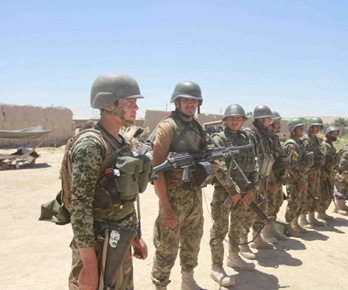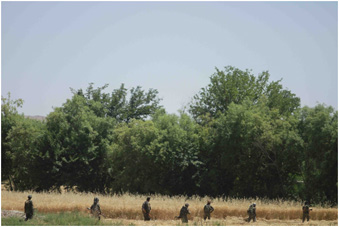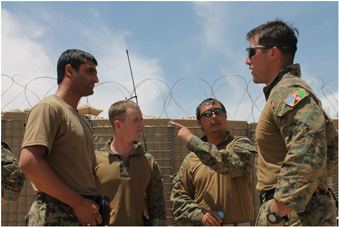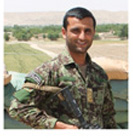Cautious Hope in Sangin
Joe Falvey and Dom Pellegrini
Hard-won progress in one of Afghanistan’s most violent districts, with warnings from the Afghan National Army for looming decisions about U.S. involvement in the embattled country.
From behind sandbags on the roof of a mud compound in Sangin’s Northern Green Zone, Marine advisors to the Afghan National Army (ANA) were supporting operations to thwart the Taliban’s spring offensive, which to that point had been a stunning enemy success. On that day in late May 2013, the Afghan soldiers of Patrol Base Shamsher Do were fighting to retrieve the body of their company commander, Captain Elham, whom insurgents had ambushed deep in the lush labyrinth of improvised explosive devices (IEDs), winding canals, and overgrown thickets forebodingly referred to as the “jungle” by locals. The patrol base was chaotic as soldiers fired mortars, machineguns, and recoilless rifles in all directions desperately seeking a phantom-like enemy in the surrounding vegetation and treelines. They wanted revenge for their fallen commander and they thought they needed U.S. support, especially air power, to suppress the elusive insurgents.
During the previous three years, the Marine Corps had deployed every weapon in its arsenal and suffered heavy casualties to wrest control of Sangin from the Taliban, but this was the first major ANA operation conducted with minimal American involvement. Although helicopters buzzed overhead and soldiers glimpsed fighter jets among the clouds, our rules of engagement prevented aircraft from engaging the unseen enemy or helping the ambushed company commander lost in an impenetrable jungle. Having heard that U.S. support was ebbing and their last advisors might even depart Sangin within a few months, Afghan soldiers did not know how they would perform while fighting independently and the result of the operation remained in doubt. Their performance during the operation would provide insight into the Afghan Army’s preparedness for U.S. withdrawal, as well as tactical perspectives crucial to decisions about U.S. support before and after the looming 2014 deadline.
The Spring Offensive
When the Taliban announced its spring offensive by overrunning three Afghan Police patrol bases in Sangin’s Northern Green Zone, panic was palpable. We had yet to see the ANA under such duress in four previous months of fighting despite daily casualties and increased insurgent activity in the district. On the brink of transferring nationwide lead security to the Afghan National Security Forces (ANSF), Afghan and American leaders seemed especially concerned. The events in Sangin quickly became a national issue given the grave implications of a Taliban victory or slightest perception thereof, so near the transfer of lead security planned for June. As the Afghan Army’s advisors, it was our job not only to advise our Afghan counterparts, but also to quell or confirm the fears of Afghan and American leaders as we planned the counteroffensive, coordinated limited U.S. support, and operated alongside the Afghans during execution.
It was under these circumstances that our small advisor team found itself supporting Afghan forces throughout the operation, serving on the frontline of American support but generally removed from that of Afghan soldiers in daily contact with insurgents. From rooftops and high ground in the green zone, we provided “overwatch” as the Afghan Army maneuvered against the enemy. Our overwatch responsibilities were threefold. First, we provided situational awareness for American leaders who were eager to hear news of the Afghans’ progress and seemed uncomfortable at best to hear of their setbacks. Second, we served as a bridge to limited U.S. support, particularly air casualty evacuation (CASEVAC) for the urgently-wounded and surveillance platforms to track enemy movements. Third, we assisted the Afghan soldiers with their own heavy fire support weapons, such as mortars, machineguns, and recoilless rifles, which at times had devastating effects on Taliban forces. These three responsibilities were notable in that they represented a significant diminishment of U.S. support, especially compared with truly partnered combat operations of years prior.
Day One

The Soldiers of Patrol Base Shamsher Do Assemble Before Entering the Jungle (Photo by Bryan Peterson)
With darkness approaching on the first day of the counteroffensive, from the roof of Patrol Base Shamsher Do, we watched twenty exhausted Afghan soldiers ominously patrol single-file toward the sounds of machinegun fire and explosions. Many of them did not think that they would return and sadly, some were right. Throughout the morning, we had fought alongside these men while assisting them with firing their heavy weapons in an attempt, albeit futile, to extract our friends from a series of deadly ambushes. Tensions peaked when Company Sergeant Naqib frantically informed us that his commander, Captain Elham, had been slain and insurgents had captured his body.
In response, Naqib and his soldiers looked to us with urgent pleas: Why aren’t your helicopters shooting? Can’t you call the planes to drop bombs like they used to? Why aren’t you helping us? Why are you here? The situation degenerated quickly as soldiers lashed out with rockets, mortars, and machinegun fire into the dense vegetation because we were unable to support them as Marines once had. As Captain Elham’s corpse floated down a canal, stripped of his uniform, rifle, and even his cell phone, we could only tell his soldiers that U.S. air power could not help.
It was our unfortunate duty to urge the Afghan soldiers to continue the mission, however futile and callous it seemed, without the support we so badly wanted to give. And so the soldiers of Shamsher Do filed out of the patrol base to retrieve the body of their fallen commander and we remained on the sidelines. The firefight continued into the evening as the first day of what was to be a nearly month-long operation finally came to a close. The soldiers returned to their patrol base having lost five men and with the naked body of their commander in tow. Insurgents had already used his stolen cell phone to threaten his young daughter in Kabul.
Despite high emotions and near violent confrontation, we made amends with our counterparts and Company Sergeant Naqib welcomed us back to his patrol base for the duration of the operation as the ANA came to better understand the role U.S. forces now play. Despite dire beginnings, the soldiers of Patrol Base Shamsher Do, and others throughout Sangin, fought relentlessly to gain back lost terrain and ensure that their friends and commander had not died in vain. With mounting confidence in their own fire support and an understanding of the battlefield unrivaled by Marines, the Sangin ANA began to build momentum. After weeks of brutal fighting, they achieved a fragile victory, giving good reason for cautious hope in the Afghan Army’s ability to maintain security in Sangin. Although it lacked the textbook planning and methodical execution envisioned by Western military instruction manuals, it was an effective “Afghan solution” and the ANA’s independent accomplishment should not be diminished: hundreds of soldiers and police, with a plan that incorporated mobile forces, mortar fires and explosives disposal specialists, cleared acres of jungle laced with IEDs and overcame debilitating casualties to drive out a shadowy enemy reinforced by foreign fighters.

The Soldiers of Patrol Base Shamsher Do March Single-file Into the Jungle. (Photo by Bryan Peterson)
Success with Limited Support
Even more impressive is the fact that this operation occurred with nearly no U.S. support. With advisors awaiting a command decision regarding their departure from Sangin, the only tangible support received by the Afghan Army was surveillance and air CASEVAC (in addition to the funding and training that sustain the force). This support required minimal U.S. risk, but it was a tremendous benefit to the ANA: Surveillance, by both aviation platforms and blimp-mounted cameras, maintained real-time observation of the entire jungle and deterred Taliban infiltration, IED emplacement, and sneak attacks. Helicopter CASEVACs for the many traumatic casualties bolstered soldiers’ confidence that their burgeoning Afghan medical capabilities would be backstopped by the best combat medical care in the world, an irreplaceable morale boost.
Other U.S. support provided to the ANA in the past, such as manpower, explosives disposal, fires and close air support, was not provided during the operation. Although a robust capability still exists in Helmand, the support is, more often than not, withheld: young Marines still bravely risk life and limb throughout the province but venture “outside the wire” far less often than years prior, the artillery rocket systems at Camp Leatherneck remain quiet, and jets fly over for surveillance but seldom drop bombs. Judging by ANA intercepts of Taliban radio traffic stating that insurgents have nothing to fear from jets zipping overhead, even the enemy understands our current approach. The rationale for this approach is that we must prepare the ANA for our exit by withholding support while we are still here, with the ability to support in extremis if necessary. This results in challenges when advising Afghan leaders who drive through minefields in Ford Ranger pick-up trucks while our overwhelming air power and hulking armored vehicles remain inside friendly lines. But we do not describe the support (or lack thereof) to debate whether a more effective approach would be providing maximum support now in order to leave the ANA in a more advantageous position when we depart. Rather, we describe the very limited nature of current U.S. support to emphasize how capable the Sangin ANA have become, despite serving in one of Afghanistan’s most violently-contested districts. Supported by only U.S. surveillance and helicopter CASEVACS, the large-scale operation demonstrated the ANA’s growing independence and hopeful future. This resulted in the decision to withdraw Sangin ANA advisors shortly after completion of the counteroffensive.
It was certainly a difficult question to determine when the Sangin ANA were ready to conduct this fight on their own – no one, Afghan or American, could ever be entirely prepared to succeed in this complex and frustrating conflict. Based on their victories during the 2013 fighting season, however, we believe that they are presently capable of overcoming the many challenges still faced and implementing Afghan solutions to limit Taliban influence in Sangin. Although our mission in Sangin will draw to a close, Afghan soldiers will persevere because they must. As we depart, we leave behind brothers-in-arms. While eating a final meal with our Afghan counterparts, their sincere gratitude for the last decade of U.S. support required no translation. Our final contribution to them is telling their story: the Sangin ANA’s current success and willingness to fight on their own should be encouraging to all Afghans and Americans. If the Afghans in war-torn Sangin are capable of preserving the progress won by British and American sacrifice, they can do it anywhere, resignation to impotence is unwarranted, and there is much hope to be found in Afghanistan’s Army.
A Warning
This hope and the Afghan Army’s current successes could be jeopardized, however, by decisions now under consideration. As reported in July by various news outlets, including the New York Times and Washington Post, U.S. leaders are still deliberating the pace of American withdrawal leading up to the 2014 deadline, as well as the extent of American presence and financial assistance post-2014. In addition to assessing an accelerated departure, they are also considering post-2014 options ranging from a residual force to the “zero option” of no U.S. presence. A complete pullout and funding cuts have become increasingly attractive due to recent quarrels at strategic levels between Washington and Kabul. To the discussion of withdrawal pace and post-2014 presence, we would like to add a cautionary perspective from the Afghan Army at the tactical level. We share this perspective acknowledging that indisputable conclusions should not be drawn from singular events and our experiences at the tactical level did not provide full visibility of strategic considerations. Given that context, we believe that facts on the ground should inform decision-making at all levels: just as it required in-depth assessment to determine when the Sangin ANA no longer needed advisors, the Afghan Army’s actual capabilities should inform plans for our future involvement in Afghanistan.
To continue successes like those we observed in Sangin, the Afghan Army still needs limited U.S. support, especially surveillance, helicopter CASEVACs, and training. This support requires relatively minimal risk of American lives but they are key advantages on a battlefield that often favors a shadowy enemy. Surveillance assets are our “eyes” which extend over massive populated areas and deter enemy activity, particularly at night. Without it, the Afghan Army would truly be operating in the dark while fighting the Taliban on a much more level playing field. Even more crucially, helicopter CASEVACs save lives and bolster ANA morale, especially in areas where Afghan soldiers risk daily gunshot wounds and limb amputations. Finally, the Afghan Army needs U.S. training cadres to continue its professionalization and mastery of subjects that stymie even advanced militaries, such as fire support, logistical systems, and command and control. Such limited support will require a small residual footprint of U.S. forces, while still allowing steep reductions in areas such as manpower, advisors, U.S. fires and air support. We wholeheartedly agree that the Afghan Army’s growing capabilities and independence permit such reductions throughout our pre-2014 withdrawal. But the Afghan Army will not soon achieve our technological proficiency in surveillance and CASEVACs, nor the professional expertise of our military. Given the significant advantages and grave sacrifices preserved by limited U.S. risk, we should provide this support until the Afghan Army is prepared to thrive without it.
In addition to assisting with these critical capabilities, plans for future involvement in Afghanistan should include funding necessary for the Afghan Army to build on current successes. Most estimates forecast that it will cost approximately four billion dollars per year to sustain the Afghan Army in the near future, a number that far exceeds the Afghan government’s current funding ability. Without continued U.S. financial assistance, Afghan soldiers ready to fight for their country will lack the essential supplies and ammunition to do so. The average Afghan soldier is not lavishly equipped: in Sangin, he patrols into the jungle with ragged boots and a Vietnam-era rifle. Even so, he is willing to fight if he has fuel for travelling to the battlefield, ammunition for defending his post, and medical supplies for treating casualties. U.S. leaders should remember the destabilizing effects of drastic funding cuts from the Soviet experience in Afghanistan in the 1980s and 1990s. Throughout the 1980s, the Soviet Union used military forces and financial assistance to support an allied government in Kabul, just as we do now. Although mujahideen resistance expelled Soviet military forces from Afghanistan in 1989, the country did not immediately descend into the chaos that pervaded the 1990s. Even without significant military support, President Najibullah’s government maintained a semblance of order thanks to continued Soviet funding. It was not until 1992, when Soviet financial assistance was cut off, that President Najibullah fell and a chaotic power struggle led to Taliban rule in which extremism festered. It would be wise to ensure that steep financial cuts for the Afghan Army do not have similarly destabilizing effects. Afghan soldiers like Captain Elham now contribute most of the blood in this war; we should provide the treasure necessary to sustain them on the battlefield until the Afghan government can do so on its own.
Based on our perspective on the Afghan Army’s tactical capabilities, the “zero option” and drastic funding cuts would seriously impair the ANA’s ability to preserve its security gains in Sangin and throughout Afghanistan. The Afghan Army will need financial assistance and limited U.S. support, most likely past 2014, to sustain its progress and forces in the field. In particular, a Bilateral Security Agreement that affirms a steady U.S. commitment would help assure stability during and after our withdrawal. In Sangin, local elders would tell us that they were unsure of the area’s future without American involvement. They are a hard, embattled people who have learned to survive by siding with the strongest tribe. With limited support and resolve that lasts through fighting seasons and election cycles, we believe that the Afghan Army can surmount coming challenges and remain that strongest tribe.
Their struggle will feature both triumphs and setbacks: one month after the successful ANA counteroffensive in the Northern Green Zone, on our final day “outside the wire,” we again conducted overwatch for Afghan maneuver forces. Only then we stood on the walls of the Afghan Army’s newest position, Patrol Base Elham, named for the commander who gave his life for the very terrain on which we stood. Our day at Patrol Base Elham epitomized our experiences, both good and bad, with the Afghan Army. As bullets cracked overhead, Afghan soldiers attacked toward the gunfire, attempting to route cagey insurgents from their final stronghold deep in the jungle. After taking casualties, ANA momentum stalled. They requested air support from their American friends and we denied them the aircraft and bombs, so they did their best with their own heavy weapons. Although they bravely fought on, that day was not to be the same success as operations one month prior. As night fell, the soldiers and insurgents settled into a stalemate, readying to continue the scuffle in the morning. Due to the nature of this conflict, such stalemates will remain far more common than decisive victories, making it difficult for the people of Afghanistan to choose the strongest tribe. As a result, the Afghan people will be swayed and victory made possible only by the long-term resolve of the Afghan Army and our persistent commitment to supporting them at diminishing levels but beyond that of a “zero option.”

Captain Elham (left) and Advisors Discuss Operations at Patrol Base Shamsher Do. (Photo by Jonathan Eisele)
Cautious Hope
Despite tactical setbacks on our final day, we observed much reason for hope at Patrol Base Elham. After returning from the failed attack, the new ANA commander, Captain Hamid, approached us with a characteristic smile and explained that unexpected resistance had exhausted his men. They would fight another day. When he thanked the Marines for their presence and we replied ruefully that we wished we could have helped more, he assured us, “Your presence here is a gift and the battle is no longer yours to fight.” Captain Hamid’s willingness to take complete responsibility for the fight and the future of his country is rare amongst leaders of any military; however, we have seen this willingness in the Sangin ANA and they are ready to continue the fight with leaders like Captain Hamid in command.
As they fight, battles will be won and lost, but the ANA in Sangin and throughout the entire country are unlikely to lose this war at the tactical level. It remains for Afghan and American decision-makers at all levels to capitalize on the many reasons for cautious hope made possible by soldiers fighting every day, such as those on the frontlines at Patrol Base Elham. Although it is tempting to let this tiresome and frustrating war fade away, it will not end because we want it to. Victory is possible in Afghanistan, just as it is in Sangin at present, if the Afghan Army’s actual capabilities inform withdrawal decisions and limited U.S. support enables the Afghan soldier to stay in the fight. We owe as much to the Afghans who have stood with us for the past decade, to the servicemen whose sacrifices have brought us to the cusp of victory, and to future generations whose safety would be put at risk by a lackluster withdrawal.

Captain Elham (Photo by Jonathan Eisele)
Their views expressed here are the authors’ own and do not represent those of the U.S. Marine Corps or Department of Defense.
About the Author(s)
Comments
In July 2013, at the request of the ANA, a British team provided support in Sangin: 'The operation saw troops from the UK-mentored 3/215 Brigade....(the only specific role given was)..."limited casualty evacuation support" (and the report ends, rather optimistically)...Operating in Sangin over the past week, they have moved to another level of performance and independence..It has been a very impressive demonstration of what the Afghan National Army can be capable of'.
